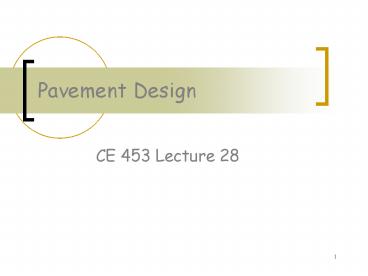Pavement Design - PowerPoint PPT Presentation
1 / 36
Title:
Pavement Design
Description:
Know variables involved in and be able to ... Level and type of usage. 32. FAILURE EXAMPLES. Primarily related to design or life-cycle, not construction ... – PowerPoint PPT presentation
Number of Views:1932
Avg rating:3.0/5.0
Title: Pavement Design
1
Pavement Design
- CE 453 Lecture 28
2
Objectives
- Understand and complete ESAL calculation
- Know variables involved in and be able to
calculate required thickness of rigid and
flexible pavements
3
AASHTO Pavement Design Method Considerations
- Pavement Performance
- Traffic
- Roadbed Soil
- Materials of Construction
- Environment
- Drainage
- Reliability
- Life-Cycle Costs
- Shoulder Design
4
- Two Categories of Roadway Pavements
- Rigid Pavement
- Flexible Pavement
- Rigid Pavement Typical Applications
- High volume traffic lanes
- Freeway to freeway connections
- Exit ramps with heavy traffic
5
- Advantages of Rigid Pavement
- Good durability
- Long service life
- Withstand repeated flooding and subsurface water
without deterioration
6
- Disadvantages of Rigid Pavement
- May lose non-skid surface with time
- Needs even sub-grade with uniform settling
- May fault at transverse joints
- Requires frequent joint maintenance
7
Flexible Pavement Typical Applications
- Traffic lanes
- Auxiliary lanes
- Ramps
- Parking areas
- Frontage roads
- Shoulders
8
- Advantages to Flexible Pavement
- Adjusts to limited differential settlement
- Easily repaired
- Additional thickness added any time
- Non-skid properties do not deteriorate
- Quieter and smoother
- Tolerates a greater range of temperatures
9
- Disadvantages of Flexible Pavement
- Loses some flexibility and cohesion with time
- Needs resurfacing sooner than PC concrete
- Not normally chosen where water is expected
10
Basic AASHTO Flexible Pavement Design Method
- Determine the desired terminal serviceability, pt
- Convert traffic volumes to number of equivalent
18-kip single axle loads (ESAL) - Determine the structural number, SN
- Determine the layer coefficients, ai
- Solve layer thickness equations for individual
layer thickness
11
Basic AASHTO Rigid Pavement Design Method
- Select terminal serviceability
- Determine number of ESALs
- Determine the modulus of sub-grade reaction
- Determine the slab thickness
12
Variables included in Nomographs
- Reliability, R
- Incorporates a degree of certainty into design
process - Ensures various design alternatives will last the
analysis period - Resilient Modulus for Roadbed Soil, MR
- Generally obtained from laboratory testing
13
Variables included in Nomographs
- Effective Modulus of Sub-Grade Reaction, k
- Considers
- Sub-base type
- Sub-base thickness
- Loss of support
- Depth to rigid foundation
- Drainage Coefficient, mi
- Use in layer thickness determination
- Applies only to base and sub-base
- See Tables 20.15 (flexible) and 21.9 (rigid)
14
(No Transcript)
15
(No Transcript)
16
Other Growth Rates
- Multiple payment compound amount factor, with i
growth rate - G (1i)n-1/i
17
(No Transcript)
18
(No Transcript)
19
(No Transcript)
20
(No Transcript)
21
(No Transcript)
22
(No Transcript)
23
(No Transcript)
24
(No Transcript)
25
(No Transcript)
26
(No Transcript)
27
Flexible Pavement Design
- Pavement structure is a multi-layered elastic
system, material is characterized by certain
properties - Modulus of elasticity
- Resilient modulus
- Poisson ratio
- Wheel load causes stress distribution (fig 20.2)
- Horizontal tensile or compressive
- Vertical maximum are compressive, decrease with
depth - Temperature distribution affects magnitude of
stresses
28
Components
Sub-grade (roadbed) course natural material
that serves as the foundation of the pavement
structure Sub-base course above the sub-grade,
superior to sub-grade course Base course above
the sub base, granular materials such as crushed
stone, crushed or uncrushed slag, gravel, and
sand Surface course upper course of the road
pavement, should withstand tire pressures,
resistant to abrasive forces of traffic, provide
skid-resistant driving surface, prevent
penetration of surface water 3 inches to gt 6
inches
29
Economic Analysis
- Different treatments results in different designs
- Evaluate cost of different alternatives
30
Sensitivity Analysis
- Input different values of traffic volume
- Compare resulting differences in pavement
- Fairly significant differences in ADT do not
yield equally significant differences in pavement
thickness
31
OTHER ISSUES
- Drainage
- Joints
- Grooving (noise vs. hydroplaning)
- Rumble strips
- Climate
- Level and type of usage
32
FAILURE EXAMPLES
- Primarily related to design or life-cycle, not
construction - All images from Distress Identification Manual
for the Long-Term Pavement Performance Program,
Publication No. FHWA-RD-03-031, June 2003
33
FATIGUE CRACKING
34
RUTTING
35
SHOVING
36
PUMPING































